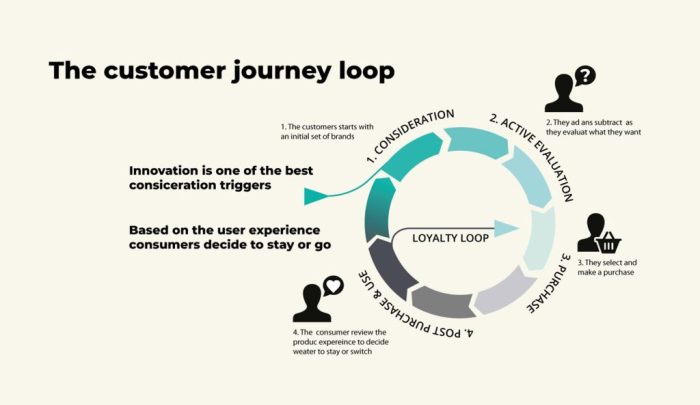Understanding the Customer Journey sets the stage for businesses to thrive in a world where customer experience reigns supreme. Get ready to dive into the intricacies of customer interactions with a fresh perspective that promises to enlighten and inspire.
Exploring the essence of customer journeys unveils a roadmap crucial for businesses seeking to forge lasting connections with their clientele.
Understanding the Customer Journey
In a business context, the customer journey refers to the complete sum of experiences that customers go through when interacting with a company and its products or services. This journey typically includes all touchpoints from the initial awareness stage to the final purchase and beyond.
Importance of Understanding the Customer Journey
Understanding the customer journey is crucial for businesses because it allows them to:
- Gain insights into customer behavior and preferences
- Identify pain points and areas for improvement
- Personalize marketing strategies and communication
- Enhance overall customer experience and satisfaction
Contribution of Different Touchpoints to the Customer Journey
Various touchpoints play a significant role in shaping the customer journey. Some examples include:
- Website visits: Customers may first interact with a company through its website, exploring products or services.
- Social media engagement: Social platforms provide opportunities for customers to engage with a brand and seek recommendations from peers.
- Customer service interactions: Positive or negative experiences with customer service representatives can impact the overall journey.
- Email marketing: Targeted email campaigns can nurture leads and guide customers through the purchase process.
Mapping the Customer Journey
Mapping out the customer journey is a crucial step in understanding how customers interact with your business from the initial contact to the final purchase. By visualizing this process, you can identify areas for improvement and create a more seamless experience for your customers.
Process of Mapping out the Customer Journey, Understanding the Customer Journey
- Start by defining the stages of the customer journey, such as awareness, consideration, decision, and retention.
- Identify the touchpoints where customers interact with your business, including social media, website, customer service, and more.
- Gather data from customer interactions, surveys, and feedback to understand how customers move through each stage.
- Create a visual map that Artikels the customer journey from start to finish, highlighting key actions and emotions at each stage.
Steps to Create a Customer Journey Map
- Research your target audience to understand their needs, preferences, and pain points.
- Identify all possible touchpoints where customers may interact with your brand.
- Plot out the customer journey stages and map the customer’s actions, thoughts, and emotions at each touchpoint.
- Consider different customer personas and how their journeys may vary based on their unique characteristics.
Importance of Identifying Customer Pain Points During Mapping
- Pinpointing customer pain points allows you to address areas of dissatisfaction and improve the overall customer experience.
- By understanding where customers struggle or encounter challenges, you can tailor solutions to meet their needs and enhance loyalty.
- Customer pain points can reveal opportunities for innovation and differentiation in a competitive market.
Customer Personas

Customer personas are fictional representations of your ideal customers based on market research and real data about your existing customers. These personas help businesses understand their customers better and tailor their marketing strategies to meet their specific needs.
Role of Customer Personas
Customer personas play a crucial role in understanding the customer journey by providing businesses with a deeper insight into the motivations, preferences, and behaviors of their target audience. By creating detailed customer personas, businesses can personalize their marketing messages, products, and services to better resonate with their customers.
- Customer personas help in identifying the pain points and challenges faced by different customer segments.
- They enable businesses to create targeted marketing campaigns that are more relevant and engaging.
- Customer personas assist in developing products and services that meet the specific needs of different customer groups.
- They guide businesses in improving customer satisfaction and loyalty by delivering a more personalized experience.
Creating Effective Customer Personas
To create effective customer personas, businesses should gather data from various sources, including surveys, interviews, and social media analytics. It’s essential to include both demographic information (age, gender, location) and psychographic details (interests, values, lifestyle) to paint a holistic picture of the customer.
- Start by conducting market research to identify common traits and characteristics among your target audience.
- Segment your customers based on their needs, behaviors, and preferences to create distinct personas.
- Give each persona a name, background story, and specific goals to make them more relatable and human-like.
- Continuously update and refine your customer personas based on new data and feedback to ensure their accuracy.
Touchpoints Analysis

When we talk about touchpoints in the customer journey, we’re referring to all the interactions a customer has with a brand throughout their buying process. These touchpoints can be online or offline, and they play a crucial role in shaping the overall customer experience.
Significance of Touchpoints
Touchpoints are significant because they are where customers directly engage with a brand. Each touchpoint provides an opportunity for the brand to make a positive impression and build a lasting relationship with the customer. On the flip side, negative touchpoints can lead to dissatisfaction and drive customers away.
- Ensuring a seamless and positive experience at each touchpoint can increase customer satisfaction and loyalty.
- Optimizing touchpoints can lead to higher conversion rates and improved customer retention.
Impact of Positive and Negative Touchpoints
Positive touchpoints can leave a lasting impression on customers, leading to repeat purchases and positive word-of-mouth. On the other hand, negative touchpoints can damage brand reputation and result in customer churn.
It’s essential to identify and address both positive and negative touchpoints to create a consistent and delightful customer experience.
Optimizing Touchpoints Strategies
Optimizing touchpoints involves analyzing customer feedback, monitoring interactions, and making improvements to enhance the overall customer journey. Here are some strategies to optimize touchpoints:
- Personalize interactions to make customers feel valued and understood.
- Streamline processes to reduce friction and make it easier for customers to navigate touchpoints.
- Invest in training to ensure that employees are equipped to deliver exceptional experiences at every touchpoint.
- Use technology to track and analyze customer behavior to identify pain points and areas for improvement.












